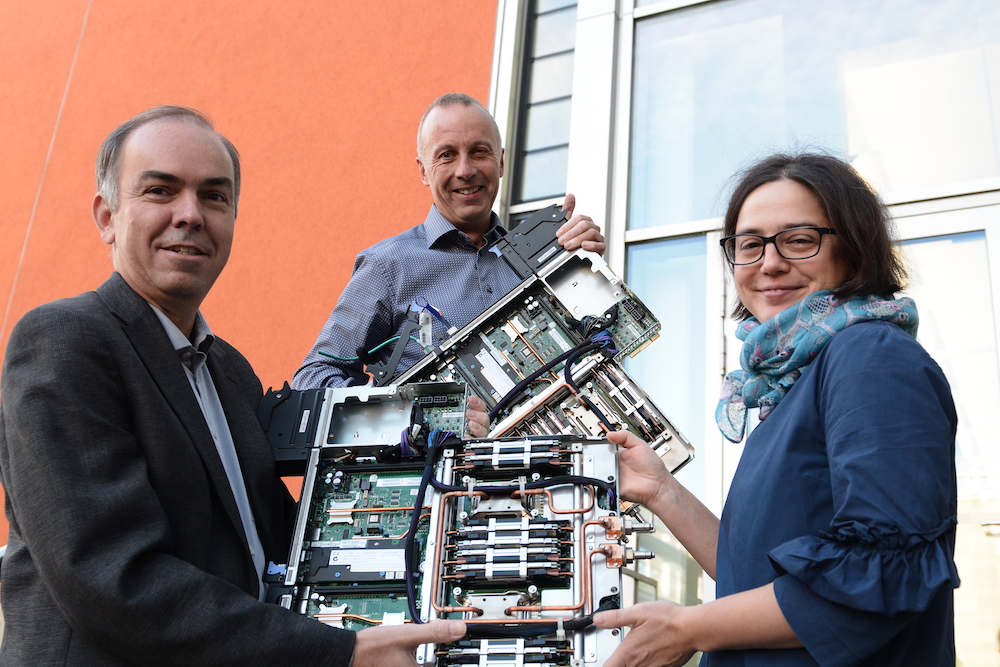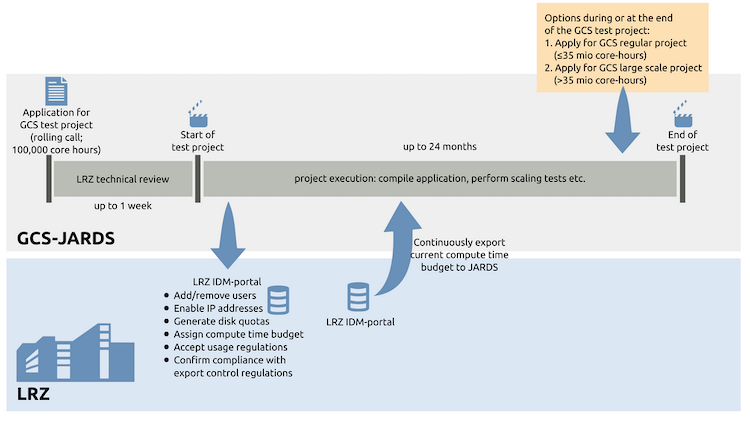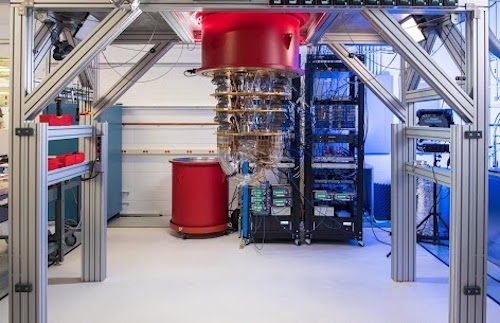LRZ-Newsletter Nr. 12/2019 english of Dec 5th 2019

You will find this newsletter in German on the LRZ-Website
Our Topics:
- News
- Workshops and Events
- Job Opportunities
- More to Read
- Informations about the LRZ-Newsletter
- Imprint
News
Adieu SuperMUC Phase 1

It weighed about as much as 42 African elephants and now belongs to the old iron: After counting more than nine billion core hours, the 250-ton SuperMUC-Phase 1 of the Leibniz Supercomputing Centre (LRZ) has now been dismantled and recycled to make room for its successor. At least one node with circuit boards and processors of the supercomputer, which was in service from 2012 to 2018, still reminds us of its achievements, records and technical details in the collections of the Deutsches Museum in Munich.
Supercomputing history
In October, Professor Dieter Kranzlmüller, Head of the LRZ, and Dr. Herbert Huber, Head of High Performance Systems Division at LRZ, handed over the discarded technology to Dr. Carola Dahlke, who curates the exhibits on computer science and cryptology at the Deutsches Museum. With "Calculated", the museum has, by the way, been showing a work sample of SuperMUC worth seeing for some time now: The film about the universe and its becoming consists primarily of simulations of the history of the earth and space, which were calculated and visualized on SuperMUC based on massive amounts of research data.
Big data and visualizations
The SuperMUC, actually a system consisting of two computer systems SuperMUC Phase 1 and 2, was set up and expanded to process huge amounts of information. The Free State of Bavaria and the federal government spent 133 million euros on it. "The rapid development of computer science means that such a computer is so outdated within six to seven years. After that, its operation is no longer economical," explains Professor Dieter Kranzlmüller, head of the LRZ. That's why the SuperMUC is now slowly being dismantled. You can read more about the performance, records and technical achievements developed with this system and about the heavy user of the SuperMUC on the LRZ website: our reading recommendation for the holiday season. (vs)
Bavarian Team Spirit Drives Success
Researched at the Ludwig-Maximilians-Universität München (LMU), simulated and visualised at the Leibniz Supercomputing Centre (LRZ) in Garching: high-resolution 3D models illustrating the geological development of the Earth's mantle and tectonic plate movements were awarded the "Best Use of HPC in Energy" prize at SC19 in Denver, the world’s leading supercomputing conference and trade fair. The trade magazine HPCwire chose this geophysical study made in Bavaria because it would potentially allow utilities to better as it potentially provides better insight and predictive power for energy companies looking to minimize the environmental footprint from subsurface resource extraction.
Cooperations like these enrich supercomputing: This was demonstrated at the stand of the Bavarian Supercomputing Alliance, an association of Bavarian universities, research institutes and the LRZ, in several respects. At the leading supercomputing trade fair in the USA, not only the three-dimensional earth models of geophysicist Hans-Peter-Bunge and his team were honoured, but also the images of interstellar turbulence after the explosion of a supernova based on scientific work by Christoph Federrath (Australian National University) caused a sensation. The team around the astrophysicist Salvatore Cielo from the LRZ was among the finalists for the prize for the best scientific visualization in HPC. "Bavaria is a hotspot for innovative HPC research and applications," comments Dieter Kranzlmüller, Director of the LRZ, on the successful cooperation and the honours: "We not only have the systems, but also the clever minds to provide an ideal research environment for super and future computing in Bavaria for Bavaria, Germany and Europe.
Powerful supercomputing
The stand of the Bavarian Alliance focused on energy-efficient HPC, performance engineering and applications in astrophysics, geophysics, climate research and life sciences. In addition, the current supercomputer SuperMUC-NG: With a benchmark performance of 19.5 Pflop/s, it was able to maintain its ninth place in the worldwide ranking of the fastest 500 supercomputers ranking of the fastest 500 supercomputers. "We didn't expect that," admits Kranzlmüller. "In our fast-moving industry it is unusual that there are no newcomers to the Top10 in the six months since the last list.
Even better than on the Top500, SuperMUC-NG scored in the so-called SSSP ranking of the Graph500 list: The Graph500 list also appears twice a year and focuses on how supercomputers deal with more complex problems, such as searching and sorting data. The SuperMUC-NG is at the forefront of this - also a result of team spirit and cooperation.(vs)
A lot of work for SuperMUC-NG
Twice a year, in February and October, the Gauss Centre for Supercomputing (GCS) awards computing time for the three national scientific supercomputers in Jülich, Stuttgart and Garching. In the 2019/20 research year, the machines will consume 1.87 billion hours of computing time for a total of 43 projects. SuperMUC-NG of the Leibniz Supercomputing Centre (LRZ) in Garching will handle 13 projects and about 797.4 million core hours. To give you a better idea: More than 91,000 people would have to calculate day and night for a whole year to achieve this performance, because SuperMUC-NG consists of more than 310,000 computer cores and 6480 nodes, which bring about the power of about 80,000 personal computers.
But SuperMUC-NG gets even more work to do. It can also be accessed by European and regional researchers. "Projects that require more than 35 million core hours can apply via the GCS, and European research institutes can apply for computing time via the calls for proposals of the Partnership for Advanced Computing in Europe (PRACE). Researchers with medium or smaller tasks contact the LRZ directly," explains Dr. Matthias Brehm, deputy head of the High Performance Systems Division at the LRZ, how Bavaria's largest scientific computing centre manages access to the coveted machine. Statistics also refer to users from the USA, New Zealand, Turkey and other non-EU countries: they were given computing time because they were involved in national or European projects or transferred to other chairs during their work.

Strict selection to ensure high standards
Access to the system is granted for one or two years. "Large-scale GCS projects require a defined, tight work plan for the consumption of the allocated computing hours within one year," the GCS states. Such conditions are also formulated by the other institutions. In addition, GCS, PRACE or the LRZ require a detailed description of the research project as well as computer programs that make efficient use of the supercomputer's resources and have been extensively tested beforehand.
Whether international, national or regional - all data are checked for quality, utility and scientific sense. The SuperMUC-NG Steering Committee is responsible for this in the LRZ. In addition to the Bavarian Academy of Sciences and Humanities (BAdW) as the responsible body of the LRZ, the Bavarian government, the Bavarian universities and the Deutsche Forschungsgesellschaft, Germany’s research funding organization, are represented. In addition to the two professors Peter Bastian from the Heidelberg University and Gerhard Wellein from the Friedrich-Alexander-Universität Erlangen-Nürnberg, who chair the steering committee, 13 professors and Georg Antretter, Ministerialrat at the Bavarian Ministry of Science and the Arts, coordinate their activities. Professor Heinz-Gerd Hegering, former Director of the LRZ, and Dr. René Wies of BMW assist as consultants.
Test access for quick access
As a rule, it takes two months for the submitted research projects to be evaluated and approved. However, scientists also receive test access to the system within a few days, which they also apply for directly at the LRZ and which offers them up to 100,000 CPU hours.
But not only the flagship SuperMUC-NG processes research results with large amounts of data. The Linux cluster and, more recently, the LRZ Compute Cloud offer scientists computing platforms for routine tasks or questions relating to artificial intelligence (AI) or big data: "Chairs or institutes at Bavarian universities apply for projects and computing time and nominate so-called master users," reports Dr. Brehm. Master users manage the allocation of compute time, assign access rights to students or employees at their respective institutions in the name of the LRZ.(vs)

Protection against password thieves
Personal data and accounts, people’s habits, their possessions, their acquaintances and friends is a highly sought after good in a digital world. Passwords, however, are the shovel to quickly dig up this gold. According to a study by IT security specialist Kaspersky, the theft of passwords is steadily increasing, rising by more than 50 percent in 2018 to 940,000 registered cases in Germany. The identity management (IDM) of the Leibniz Supercomputing Centre (LRZ) therefore relies on the database Have I been P(a)wned" (HIBP) of the Australian security expert Troy Hunt: "He collects passwords from hacked websites that appear on the Internet," explains Chris Kalk, IT specialist for system integration and IDM employee at the LRZ. "If one of our users sets a password, it is matched in this database. Already stolen passwords are not accepted."
555 million stolen passwords
The fifth version of HIBP has just been installed at the LRZ. The database now stores more than 555 million passwords of attacked web services, for security reasons not as plain text, but encrypted (SHA1). The users who set and change their password directly in the IDM portal of the LRZ - about 10 percent of 330,000 - have benefited from the system since the end of 2017 and can thus check their identifiers for security. The Technical University of Munich (TUM) also uses Hunt's database.
"If our system rejects a password, it is too simple, may be used by many or has already been stolen," says Kalk and warns: "Even cleverly chosen passwords are stolen by websites. If such passwords are also used for other accounts and the LRZ system rejects them, caution and a password change are required: This can be an indication that the HIBP database has already registered this password as stolen. In principle, experts such as Kalk recommend using a separate password for each account. Password safes help and generate random IDs that people find difficult to remember.
More data protection and data security
Hackers have been upgrading in recent years. They have long automated the theft with malware or password stealers - and try to gather as much information as possible about users with the identifiers.
The Cyber Security Day on March 2020 26th, which the LRZ is currently planning together with the Gesellschaft für Datenschutz und Datensicherheit (GDD) and the Munich universities, will also focus on the security of data and information on the Internet, the privacy of users and other issues relating to cyber security. One day later, on March 27th., specialists will also meet for the Data Protection Day and discuss legal and technical requirements relating to the control and protection of personal data in organisations. (vs)
Step by Step to a Quantum Computer
First the Bavarian Quantum Computing eXchange (BQCX), now a CIRQ-Bootcamp with Google: The Leibniz Supercomputing Centre (LRZ) is accelerating its preparations in the area of quantum computing. Since last summer, the BQCX has been meeting regularly on the second Wednesday of each month (next date: Decembre, 11th); the first advanced training event will take place on 16 December in Garching near Munich. The CIRQ boot camp is aimed at scientists who are developing the first algorithms for quantum computing and are passing on their experience as lecturers. CIRQ is an open source framework that can be used to write programs for specific quantum processors: "CIRQ focuses on short-term questions and helps to check whether NISQ quantum computers can also calculate practical research questions," Google explains in its Blog.
Superior technology ...

Quantum technologies are still extremely susceptible to interference and noise. There is great hope that they will be able to handle even more data in a shorter time than today's supercomputers. In an experiment in the summer Google succeeded at least in proving so called quantum supremacy with the help of a constructed example. The specially developed quantum processor Sycamore tested random, 43-digit number sequences of 0 and 1 and calculated how high the probability is that a certain combination will come about. The Google system needed 200 seconds for this statistical task, checking millions of combinations - a supercomputer like the SuperMUC-NG would have taken 10,000 of years. However, the arithmetic problem is pure theory and was precisely formulated for the Google system. So the question arises, what do Sycamore and comparable systems do for real research questions?
... but also practical?
Sycamore belongs to the first generation of Quantum-Computers, so-called "Noisy Intermediate Scale" or NISQ computers, which currently calculate with 50 to 100 Qubits. This already allows simpler calculations to be carried out. CIRQ was developed for these systems. In cooperation with scientists, Google now wants to investigate whether real research questions can be solved on NISQ computers and with this programming framework: "Quantum computing requires strong cross-sector and academic cooperation if it is to exploit its full potential," the company explains its strategy. This is why CIRQ is an open source toolset and why Google trains potential users in the use of CIRQ. The company wants to make greater use of Sycamore's capacity and to optimise it with real research tasks.
This strategy seems to work, at least when dealing with questions from quantum chemistry: With CIRQ Fermion, the first specialized tools for questions from chemistry are already available. The one-day boot camp, which Google is organizing at the LRZ in mid-December, is one of the first events of its kind in Germany and is offered worldwide. Participants will learn how NISQ computers work and how they can develop algorithms in their fields. Google is not the only company working on quantum technology. IBM p.e. has also achieved a breakthrough this year with its quantum system, and this company is also working with scientists -in its program IBM-Q, but does not rely on Open Source and sell its computertime. (vs)
Number of the month
The Leibniz Supercomputing Centre (LRZ) has just installed its 10,000 PC - a Windows-based client. 68 percent of the devices are located in an institute of the Technical University of Munich (TUM), 24 percent at the Ludwig Maximilian University (LMU) and eight percent at other LRZ clients such as the Bavarian Academy of Sciences (BAdW), the University of Music and Theatre or the Munich University of Applied Sciences. The number of managed systems and devices is currently growing, especially in the LMU. (vs)
A shout out for patience and long breath
Scientists at the Ludwig-Maximilians-Universität München (LMU) have been working for ten years on a critical edition of the works of the composer Richard Strauss, which is not due to be completed until 2035. Since 1894, i.e. more than 120 years, linguists have been studying the dictionary of the Latin language. And the Leibniz Supercomputing Centre (LRZ) has been operating, researching and developing high-tech for science for 57 years: research takes time and should not just follow short-term social trends. Like all other German national state academies, the Bavarian Academy of Sciences and Humanities (BAdW) therefore supports the above-mentioned and even more such long-term projects. Thomas O. Höllmann, sinologist and president of the BAdW, is convinced that the German research location profits from this long-term thinking and is admired abroad for this great opportunity.
Long-term research, deepening knowledge
On 2 December, the TV station ARD-alpha aired a tribute to long-term research and the benefits it brings to society and science: As results of the "Science with Long Tail", so the title of the theme evening, the SuperMUC-NG as well as the Centre for Virtual Reality and Visualisation (V2C) are shown beside other BAdW projects. In an interview with moderator Martin Posselt, Höllmann also reports that the importance of the humanities for business and technology is growing and that the natural sciences are now also increasingly dealing with individual research questions. For more than 25 years the geophysicist Professor Hans-Peter Bunge has been dealing with the history of the earth and the development of tectonic plates. The result of this patience: different, award-winning and vivid models of the earth that show earthquake zones and tsunami risks and illustrate natural phenomena in museums. Patience is worthwhile, it provides research with the basis for further questions and all knowledge. (vs)
Workshops and Events
Energy Efficiency in Supercomputing
Saving Power in data centres and supercomputing: The Leibniz Supercomputing Centre (LRZ) consumes about five megawatts of electricity, up to four megawatts flow into the new SuperMUC-NG supercomputer. So that the energy is used as efficiently as possible and consumption will even increase in the future the LRZ is already relying on an innovative cooling system with hot water and is looking for even more ways to save electricity. Data from the computer systems could help, as well as information about the programs or artificial intelligence. More strategies to save energy at supercomputing and in data centres and experiences from LRZ, you will find now in the new book "Energy Effiency Computing and Data Centers". On December 12th 2019 Luigi Brochard, the editor and publisher, is a guest at the LRZ and presents the most promising, innovative methods for saving electricity in data centers.
Deep Learning for Computer Vision
Together with NVIDIA's Deep Learning Institute (DLI), the Leibniz Supercomputing Centre offers on January 20th 2020 this one-day workshop for students, data scientists and researchers who are dealing with challenging problems with Deep Learning. Participants learn the basics of Deep Learning, how to use artificial neural networks and how to train them by data. In addition, the tools are introduced for programming Deep Learning solutions for specific research projects. Lecturer Juan Durillo Barrionuevo holds this workshop in English. To the registration.
Fundamentals of Deep Learning for Multiple Data Types
This one-day workshop introduces into the basics of Deep Learning with a wide variety of Data types, it will be presented on January 21st 2020. in the Leibnmiz Supercomputing Centre in Garching near Munich. The course is addressed to students, employees and researchers from all academic faculties. They learn how to build and to train a network with the help of programs such as TensorFlow or the so-called MSCOCO dataset, for example to sign signatures to create images and videos. Lecturer Juan Durillo Barrionuevo holds this workshop in English. To registration.
Introduction in Julia for HPC and Machine Learning
Julia is one scientific programming language that supports the syntax of Python with the speed of C. From January 27th to 28th 2020 participants of this workshop receive an insight into Julia. They learn to work with Julia and the most important differences to common programming languages. Program codes for GPU with Julia and create workflows for machine learning with the programming language. The workshop of Dr. Oliver Schulz from the Max Planck Institute for Physics and Ludger Pfähler from the Technical University of Munich (TUM) attaches great importance to the practical training, so that participants will soon be able to implement the presented methods in their programming-works. In English. To registration.
Dealing with Photoshop
Digitizing and editing images - that's what's important of this practical course by Klaus Leschhorn at January 29th 2020 at the Leibniz Supercomputing Centre. He is designed for employees, students and lecturers who are often familiar with digital images. You will learn to brighten images with Photoshop, correct colors and more, learn the most important image editing tools as well as the file formats, that Photoshop creates, and where they are used. Knowledges of Windows are required. The course is taught on German, to registration.
OpenMP Programming
OpenMP is the programming language for parallel computer systems and enables the construction of specific applications in supercomputing for a wide variety of research questions. Lecturers from various universities as well as INTEL will present participants of this PRACE workshop at February 11th 2020. at Leibniz Szpercomputing Centre into this powerful programming language and show the tricks with which it also helps advanced learners to solve data problems. To registration.
Cyber Security Day 2020
Cyber crime (identity abuse, online fraud, etc.), phishing, firewalls and much more: On March 26th 2020, there will again be a free day with lectures on the topic of (IT) security at the Research Campus Garching. The Security Day 2020 is organised and carried out by the Leibniz Computing Centre together with Munich universities and the Society for Data Protection and Data Security (GDD). These institutions want to help the participants to improve security at the workplace and in their private lives and to protect their own privacy. The participants in the Munich Science Network and the members of the GDD-ERFA-Kreis Bayern are invited to the Security Day 2020. No prior technical knowledge is required to participate. LRZ-Website.
Data Protection Day 2020
The EU Data Protection Basic Regulation (EU-DSGVO / EU-GDPR) has been in force since May 2018, as have the German Adaptation Act (BDSG) and the Bavarian Data Protection Act (BayDSG). However, there is still a lot to do and legislation and jurisdiction do not stand still. … Therefore the free Data Protection Day 2020 will take place on March 27th, 2020 at the Research Campus Garching. The organizers - besides the LRZ these are the Gesellschaft für Datenschutz und Datensicherheit (GDD) as well as the two Munich universities - want to support data protection officers and all persons who are more closely involved with data protection in their work with lectures on current topics. Participants should therefore at least have a basic knowledge of data protection. "Help from professionals for professionals" is the motto; therefore the Data Protection Day 2020 is also the 81st meeting of the GDD-ERFA-Kreis Bayern. More information at the LRZ-Website.
Standards for Interfaces Sought
The eighth international workshop around the interfaces OpenCL, SYCL, Vulkan and Spir-V, called IWOCL, will take place from April 27th to 29th 2020 at the Leibniz-Supercomputing Centre (LRZ) in Garching near Munich. Computer specialists and engineers dealing with these programming interfaces are now invited to submit field reports on the integration of these interfaces into supercomputing projects as well as proposals for their extension or standardization. The interfaces accelerate and optimize the integration of applications on special processors, such as GPUs or accelerators. They will be important for the development of the next generation of high performance computers, the Exascale computers, which will certainly no longer be able to do without accelerators. The LRZ organizes the event and is involved in the selection of presentations and papers.
Job Opportunities
The following positions are currently open at the LRZ. You will find a diverse, international team in Garching. Most job offers are in German – for questions you will find English speaking colleagues here. Don't hesitate to e-mail or phone:
- Research Associate Virtual Reality and Visualization (m,f,div)
- IT-Systemspecialist (m,f,div)
- IT-Specialist E-Health (m,f,div)
- Student Assistant: Frontend-Web-Development (m,f,div)
- Student Assistant: Service Desk (m,w,div)
You haven't found anything suitable? We look forward to your unsolicited applications.
You will find all current job offers on our website.
More to Read
Here you will find links to the latest information from the German and European supercomputing community and our cooperation partners:
- Publikations of the Gauss Centre for Supercomputing (GCS): GCSNews 25/2019 and INSIDE, Autumn 2019
- Infoletters of the Gauß-Allianz: November 2019 (PDF: 2 P.)
- PRACE: Newsletter
Informations about the LRZ-Newsletter
- The LRZ Newsletter is published in German and English. You can find the latest and former editions on the LRZ-Website.
- You have problems displaying the newsletter? Please send a short description of your problem to <NewsletterRedaktion_AT_lrz.de>. Thank You.
- You can subscribe or unsubscribe the LRZ-Newsletter via our Website.
Imprint
- Editor:
- Leibniz-Supercomputing Centre of the Bavarian Academy of Science and Humanties
- Adress:
- Leibniz-Supercomputing Centre of the Bavarian Academy of Science and Humanties
Boltzmannstraße 1
D-85748 Garching - Phone:
- +49-89-35831-8000
- Telefax:
- +49-89-35831-9700
- E-Mail:
- lrzpost_AT_lrz.de
- Editorial Office:
- PR-Team
- Photos:
- A. Podo (LRZ), Jon Moore/Unsplash, Google
